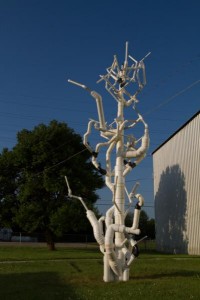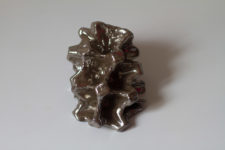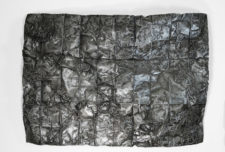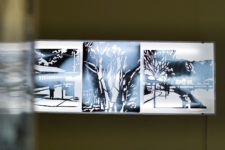Location: Paris / Chicago
Website: www.kasiaozga.com
-

- Arbor Vitae
Arbor Vitae is a publicly accessible sculpture that re-uses locally sourced industrial materials to address a theme important to Nebraska City's history and culture; man’s relationship to nature. The plastic white tree with black and grey accents, was made by assembling together differently-sized pipes, used in electricity, sewers, and construction. These "man-made" materials may seem completely different from the "natural" wood found in the nearby Arbor Day Farm, but in fact, both materials have been manipulated by humans to respond to our needs. The sculpture is located on the site of a former row of crab apple trees that were destroyed due to blight. Materials were donated by Crown-Line Plastics, and the project was supported by the Kimmel Harding Nelson Residency in Nebraska City, NE.
-

- Emballages Alimentaires
Series of ceramic sculptures with metallic glaze created using actual cardboard egg cartons, size variable, approx. 10 cm x 20 cm x 10 cm/sculpture. 2007-14.
-

- Ajka, Veszprém County, Hungary
Cast wall-hanging aluminum sculpture, 71 cm x 91cm x 2 cm, 2013-4. This relief sculpture is cast using the standard dimensions of a Rand McNally map. It is part of a series representing different sites around the world where bauxite mining has caused environmental problems. Damage to local ecosystems, harm to local constituency groups, and evidence of illegal mining operations are represented using molds of crushed aluminum cans.
-

- Internal Frontier I
Internal Frontier I (series), Hand-made cut-outs of chest x-rays shown in military-grade medical lightboxes, images measure 43cm x 35,5 cm each, 2010-2014.
Kasia Ozga depicts relationships between human bodies and physical, social, and political systems. Her recent works explore the notion of presence by addressing (im)migration, environmental justice, bodily integrity, and consumerism. She portrays change directly, through the use of organic materials intentionally affected by weather conditions, and indirectly, via visual metaphors for the experience of time. Pieces allude to the figure/body relationship by representing appendages, silhouettes, or negative impressions of the human form in media ranging from wicker to stone, from reclaimed wood to textiles, from bread to bronze.
www.kasiaozga.com
Follow me on Instagram!